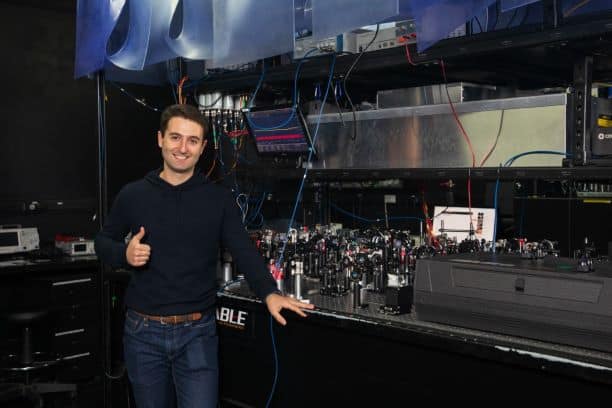Fast quantum random number generator fits on a fingertip
07 Sep 2021 Pradeep Niroula
Smartphones could soon come equipped with a quantum-powered source of random numbers after researchers in China developed a quantum random number generator (QRNG) chip small enough to sit comfortably on a fingertip. What’s more, the new integrated photonic chip generates random numbers at rate of 18.8 gigabits per second – a record-high rate that should allow the generator to interface with the ever-increasing speed of Internet communications.
Random numbers are useful in cryptography and computer simulations, among other applications. For example, cryptography needs a source of true random numbers that a sophisticated adversary or eavesdropper cannot predict or manipulate. Similarly, true randomness ensures that computer simulation techniques, like the ones used for predicting weather or modelling protein molecules, produce accurate results.
For most purposes, wherever a high degree of randomness is not necessary, pseudo-random numbers suffice. These numbers appear random, but they are actually part of a sequence generated by a formula using a so-called seed number. This means that if hackers learn the seed number, they can predict the entire sequence of numbers, thus eliminating any randomness. A security protocol based on pseudo-random numbers is therefore weak since hackers might be able to guess the keys used for encryption.
On the other hand, true random numbers – ones that cannot be guessed or anticipated – are very hard to generate because they need a truly unpredictable origin. In their quest for true randomness, researchers have even turned to measuring cosmic radiation and observing patterns in volcanic lamps.
Turning quantum noise into usable randomness
Thankfully, there is also a more accessible source of true randomness: quantum superpositions. In quantum mechanics, a wavefunction can be in a superposition of many states and performing a measurement randomly collapses the wavefunction into one of those states. An electron, for example, can be in an equal superposition of “spin up” and “spin down” states, and measuring the electron gives one of the two spin states with 50% probability. It is almost like a coin-toss, except that a coin-toss is not really random since you can predict whether the coin lands heads or tails if you accurately account all forces on the coin (flick of the finger, wind movements, and so on). On the other hand, the measurement outcome of an electron in a superposition is simply unpredictable.
The QRNG developed by researchers at the University of Science and Technology in Hefei and Zhejiang University in Hangzhou uses a setup in which a reference laser beam is split into two and the intensity of the outgoing beams is measured using ultra-fast indium-gallium-arsenide photon detectors. The difference in the two intensities is affected by fluctuations in the so-called vacuum state, which is a quantum state that contains zero photons but still has some residual energy. When you try to measure the properties of this vacuum state, such as the magnitude of its electric field, Heisenberg’s uncertainty principle guarantees that the results will, in theory, be random numbers picked from a normal distribution.
In practice, however, classical noise creeps in, giving the measurements unwanted bias and correlations that could help a hacker guess the generated numbers. To avoid this, the researchers used classical algorithms to remove unwanted correlations during post-processing, leaving only the true random numbers behind. These numbers were then transmitted to a personal computer where they passed a suite of tests showing that they are indeed random.
Random things in small packages
The security of small electronic gadgets has become more critical than ever due to the rise of the “Internet of Things” in which devices such as home appliances are connected to the Internet. QRNGs can protect such devices by supplementing conventional cryptography with truly random numbers. But to be useful, generators need to be fast enough to communicate over Wi-Fi or broadband internet. For this, a fast source of randomness is not enough on its own: the supporting photonic and electronic components used in post-processing and communication need to be just as quick. In addition, it should also be possible to embed the generator into small devices.READ MORE

According to Jun Zhang, a physicist at Hefei and a co-author of the research published in Applied Physics Letters, the fabrication process developed by the Hefei-Hangzhou team solves this miniaturization challenge. Not only did the researchers achieve a record-high speed with their generator, they also managed to squeeze most of the critical components into an area of 15 mm2, which is roughly one tenth the size of a micro-SIM card. While the current prototype chip still needs an external laser source and amplifiers, making the total package significantly larger, Zhang says the team intends to develop a low-cost version, albeit with a slower generation rate, for commercial use. If successful, such a chip would make true random numbers affordable enough for everyday laptops and smartphones.
from physicsworld.com 7/9/2021

Δεν υπάρχουν σχόλια:
Δημοσίευση σχολίου